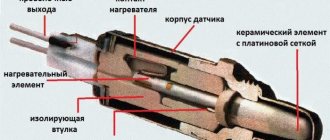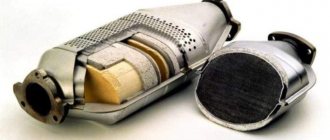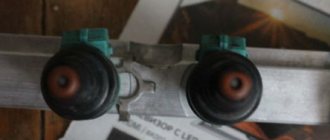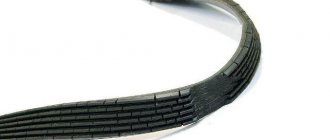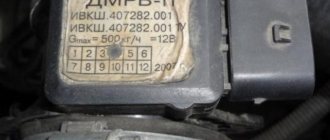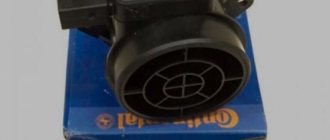Error p0172 means too rich mixture (or system too rich). Thus, a re-enriched fuel mixture is supplied to the combustion cylinders. Like the P0171 code, the rich mixture fault is systemic. That is, it does not indicate an obvious malfunction of the sensors, but the fuel quantity parameters exceed the limit value.
Depending on the reason that caused the appearance of such an error code, the behavior of the car can also be different. In some cases, noticeable fuel consumption will appear, and in others, only choking at idle or floating speed either on a hot engine or when it is still cold.
What does code P0172 mean?
The engine must receive the required amount of fuel in accordance with the air entering it. There is an optimal air-fuel ratio to provide the best power and fuel economy.
Bank 1 and Bank 2 tell you which cylinder block it is, left or right if it is a V-twin engine. Bank 1 always contains cylinder #1.
The engine control unit (ECU) uses a number of sensors such as MAF, DPKV and DT (mass air flow, crankshaft position and engine coolant temperature) to determine how much fuel to fill.
Using feedback from the rear oxygen sensor (ROS), the ECU can fine-tune the fuel injector pulse width to provide the best air-fuel ratio.
Oxygen sensor
As the name suggests, the oxygen sensor is sensitive to the oxygen (O2) content in the exhaust, which directly depends on the fuel-air mixture (FA) ratio. During combustion, some of the oxygen in the air is used to oxidize the fuel, leaving a small amount in the exhaust, which the DC measures, sending a signal back to the ECU.
If there is a lot of oxygen, this means that the engine is running on a lean mixture, that is, not enough fuel is injected. Conversely, if there is very little oxygen, this means that the engine is running rich, i.e. too much fuel is injected.
During normal operation, the controller cycles between rich and lean fuel assemblies. At the same time, the ECU studies the short-term and long-term fuel trim values (STFT and LTFT).
Typically, fuel trim will be within 3% of ideal, depending on current load, air and coolant temperature, for example.
Engine problems such as high fuel pressure, a faulty mass air flow sensor (MAF) signal, or a defective fuel injector can cause the engine to deliver more fuel than required. An incorrect message about the amount of incoming air can also lead to an over-rich mixture.
The control unit will attempt to adjust the mixture by reducing the injector pulse, but if the fuel trim exceeds -25% or so, the ECU interprets this as a malfunction, setting DTC P0172 - Fuel mixture too rich (bank 1). The Check Engine light will come on.
Expert advice
If the mixture in the fuel tank is too rich, the first thing experienced auto mechanics recommend doing is resetting the additional settings for the injector. If the owner independently adjusted the fuel control system, he could make serious mistakes. A rich fuel mixture will lead to inevitable engine failure very soon.
If the cause of the deviation is related to the injector system, this can be determined visually. With such a malfunction, traces of fuel combustion appear on the outside of the injector.
Burnt and soot can also be found on one side of the copper O-ring. Such deviations are caused by incorrect installation of the injector. If the O-ring is not in its place, similar malfunctions are also possible.
Symptoms of code P0172
Depending on the nature of the problem, P0172 may or may not be accompanied by drivability problems. At the very least, you will get better fuel economy because when the ECU is in limp mode, it no longer uses feedback from the sensors to adjust the mixture.
In severe cases, you may notice rough idling, lack of power when accelerating, even misfiring or stalling. Symptoms gradually worsen as the engine warms up.
The worst cases may be accompanied by black smoke from the muffler and a flashing warning light, warning you of possible catalytic converter damage.
You may also smell a strong fuel odor and see black soot on the tailpipe or rear of the vehicle, which indicates that there is a lot of unburned fuel passing through the exhaust system.
Other signs
Of course, there are many reasons for excessive fuel consumption. But usually the first sign here is code P0172.
There are also a number of other signs of a problem:
Noisy exhaust occurs more often at high speeds. The reason is that the fuel does not burn completely and is therefore discharged along with the gases to the outside. However, in its path there is a muffler that does not allow fuel to pass through, so it accumulates in it and explodes when it reaches a critical mass. As a result, there is a risk of destruction of the muffler itself or the resonators.
Blackish smoke comes out due to the fact that the combustion of gasoline residues occurs in the exhaust system, where the products formed during ignition are not filtered.
The loss of power is due to slow and incomplete combustion of fuel. As a result, it literally floods the candles, which leads to the loss of spark and, accordingly, to an even worse situation. In this situation, the piston does not receive a normal push and a decrease in power occurs. Sometimes this indicator is restored for some time after the car is driven at high speed, but usually the improvement does not last long.
Under such circumstances, gasoline consumption cannot but increase. The presence of a malfunction in the system does not prevent fuel from flowing into the engine, but it is used there with very low efficiency. A significant part of it is simply thrown into the wind, and in the literal sense.
Common Causes of P0172
Depending on the year, make, and model, the P0172 code can have a number of causes. Here are some of the most common ones.
- Toyota/Lexus. Dirty mass air flow sensor, usually with filters after replacement. The reasons for this dependence are not entirely clear, but many Toyota mass air flow sensors are particularly susceptible to contamination. Cleaning is usually unsuccessful. Replace the old air flow sensor and engine air filter. Clean the air chamber, install a new mass air flow sensor and air filter. It is advisable to use original spare parts. Check the seals on the air chamber.
- Oil filters. Some engines, both by design and age, can leak oil into the air chamber and then into the air filter and mass air flow sensor. Additionally, some aftermarket air filters require an oil treatment to function properly, but some car owners may be overzealous with this. Either way, excess oil can contaminate the MAF sensor, causing the airflow to be measured incorrectly. Also make sure the PCV (Positive Crankcase Ventilation Valve) and pipes are in good condition.
- Dirt. In an ideal world, your engine bay would be spotless. However, over time, dirt and grime accumulate and can easily penetrate the engine and control systems. Old and neglected cars can easily become contaminated with the air flow sensor due to dust, dirt or poor air duct sealing.
- Leaking fuel injectors. Due to aging or contamination, a fuel injector may leak, leaking fuel into the cylinder even when it is not required. Check the oil for a fuel smell, which is a good indicator of a leak.
- Leak in the fuel pressure regulator. On some vehicles, vacuum fuel pressure regulators have been known to leak internally, leaking unmetered fuel directly into the intake manifold.
Poor fuel assembly: concepts
Lean fuel mixture
- This is a fuel assembly with a reduced gasoline content and an increased air content.
The error code assigned to this error by the on-board computer is P0171. Literally, this code stands for very poor fuel supply. Sometimes poor FA is called low-calorie.
A poor fuel mixture shows itself with the following signs: very poor traction, especially noticeable on steep climbs, engine overheating, the injector makes popping sounds, and white or gray smoke comes out of the exhaust pipe.
Reasons for preparing a lean fuel assembly: fuel pump malfunction, use of gasoline with water or other impurities, fuel sensor malfunction, vacuum hoses or intake manifold malfunction, injectors supply too little gasoline, pressure sensor malfunction.
Signs of a rich mixture
The formation of a rich fuel mixture occurs with a chic set of manifestations.
- The first and most important sign: the malfunction indicator issued by the car’s on-board computer lights up. Error code: P0172.
- The car muffler makes a loud popping noise. This happens due to a lack of air in the engine cylinders and, as a result, the air burns out in the exhaust pipe.
- Exhaust gases are black or gray. This occurs due to the fact that the fuel assembly burns not in the engine, but in the exhaust pipe; the exhaust gas does not undergo any purification by filters; when burning in the pipe, the amount of atmospheric air sharply increases.
- The car is less dynamic, less powerful. This is explained by the slow combustion rate of the fuel mixture. As a result of slow fuel combustion, power failures occur. If the mixture is over-enriched, it is even possible that the car simply will not move.
- Fuel consumption has increased sharply. It is explained by the inefficiency of using the fuel mixture: it tries to cover the low combustion rate with additional injection of liquid fuel.
Problems of preparing car fuel mixture
How to troubleshoot P0172
Fuel trim monitoring uses the oxygen sensor to operate, meaning fuel trim codes are not oxygen sensor codes.
- Code P0172 together with error P0175 or errors in the mass air flow sensor. If you see a P0172 with a P0175 code or MAF-related errors at the same time, you can likely rule out individual cylinder, ignition, and fuel injector problems. Instead, focus on the fuel injection system and air flow sensor.
- Contamination of the air flow sensor can distort air measurements, so the fuel injection calculations are changed. Cleaning may solve the problem. Replacing the sensor, along with a new air filter and properly sealing the air ducts, would be a more reliable solution.
- Check fuel pressure. Make sure it is in the proper range. Excess pressure, for example caused by a faulty pressure regulator or a pinched return line, will cause more fuel to be injected than the ECU expects.
- Check that the DTOZH (coolant temperature sensor) and IAT (intake air temperature) sensor readings are correct . The control unit may not detect faulty sensors, so it is useful to check that the temperature sensors are within normal ranges. For example, if the engine was running for half an hour on a hot day, the DVT value should be at least 80 °C. If the ECU still reads 0°C, it will enrich the FA ratio to compensate, resulting in an over-rich condition.
- P0172 with other Bank 1 DTCs. If you only have a P0172 with simultaneous Bank 1 DTCs, such as cylinder misfire, then focus on Bank 1.
- Fuel pressure drop. With the engine running, record the fuel pressure, then stop the engine. Fuel pressure may drop slightly but should remain stable for at least 10 to 15 minutes. If fuel pressure continues to drop, you may have a leaking fuel injector, resulting in a rich condition and possible misfire.
- Misfire in the cylinder. A cylinder misfire will result in the release of unburned fuel into the exhaust stream. Diagnose and correct leaks before attempting to diagnose a rich mixture. Pay attention to associated error codes such as VVT (variable valve timing) or ignition system.
- Exhaust. Check the exhaust for leaks between the cylinder head and the oxygen sensor. Although the exhaust system appears to be a positive pressure system, air can enter the partial vacuum created by the exhaust gas pressure pulses. Atmospheric oxygen arriving before the DC distorts oxygen measurements.
Error 0172 Mixture too rich (SOLVED) — Lada 2115, 1.5 l., 2005 on DRIVE2
Alexey Uryadnikov, 57 years old I drive a Lada 2115 Kineshma, Russia
This error came out today. During the day she appeared 7 times. The car stalled at an intersection twice. The Internet shows many probable reasons (sensors: mass air flow sensor, air metering sensor, variable speed sensor, injectors, fuel pressure, etc.
) When warmed up, at idle, I look at the on-board computer (multitronics C350) IAC floats 80.85 Seems to be normal DC, 0.87 volts stands rooted to the spot Gas - drops to zero Seems to be normal MAF -0 Doesn’t float Seems to be normal MAF, kg per hour -13.
18 ! The norm is 9-11 kg-hour. Obviously not the norm. Moreover, when the readings jump beyond 15, at that moment error 0172 appears
Questions
DMRV died?
(More precisely, it begins to die. Will it die when it reaches 20?) If you change
How much does it cost for tag?
Which model is better to buy?
(Engine model 2111 Release 2005, injector, 8 valves, power 78 hp Engine capacity (cc): 1499.00, ) Thanks in advance. === Problem solution=== =============
SOLUTION TO THE PROBLEM!
I decided to write a solution to the problem (maybe it will be useful to someone) I want to say right away: First, there can be many reasons and my specific solution will not suit everyone. Secondly, I used a flight computer (hereinafter referred to as MK) (multitronics C350) for diagnostics. Not everyone has MKStep one.
I discovered from the MK that on a warm engine, idling, the mass flow rate should be at least 13 kg per hour.
11 I came to the conclusion that the mass air flow sensor is not working correctly (they have a frequent malfunction of overestimating the flow readings) I decided to change it. I screwed up a little. Below I will describe why. After the replacement, I noticed a positive result, but not completely.
Errors were less common, but they still appeared. Step two I started examining the oxygen sensor (OK). Let’s explain a little. The system, including the DC, is very inertial and linear. And in such systems, the regulated parameter is harmonic oscillations. In this case, the average value, amplitude and frequency are regulated.
As I understand it, the average optimal DC value is 0.5 volts, the frequency is not higher than 3 Hz (the DC reaction time is at least 0.3 seconds), the amplitude is 0.8 volts (on a working DC it ranges from 0.1 to 0.9 volts) In principle, you need to look at it on an oscilloscope. But where can I get it? But no. But okay, jump and MK will show! 0.1 - a lot of oxygen (not enough gasoline) 0.
9 - little oxygen (Too rich mixture Gasoline burns and there is still oxygen left) The DC also starts working at 300 degrees That is, until the DC warms up, the DC will not work. What did I observe? I start the car. The DC sensor shows 0.44 volts straight to the spot (This is normally close to 0.5)
Then after a minute (maybe more) the readings begin to slowly increase... 0.5 0.6 .0.7 0.8 0.9 And then everything stays at 0.9
and they don’t fall to the bottom (they float in the range of 0.85…0.09) But they should float from 0.1…0.9 During the warm-up period, the BC does not pay attention to the DC and simply deliberately gives a mixture enriched with gasoline. So for sure. Therefore, as it warms up, the DC readings begin to increase. But then the BC must take the readings of the DC and move it to 0.
1And the latter did not happen to me! At the same time, the BC is trying to reduce the concentration of oxygen in the exhaust gases as much as possible. How? Yes, it’s simple, it increases the air flow and reduces the gasoline injection time. Of course, within reasonable limits. The air flow increased to 13 kg per hour. Then I realized that the mass air flow sensor was corrected! This computer, due to a damaged DC, increased its air flow to 13 kg per hour! I realized that I was screwed up with the mass air flow sensor. What’s also surprising is that this happens at idle when the car is warming up (and not always, sometimes it starts to work normally) And when I’m driving with gas, the DC starts to work normally. That is, on the MK I see indications like 0.9 0.5 0.1 0.7 0.2 and so on That is, it jumps between 0.1 and 0.9! Yeah, I think the DC is dead and I’m a fool, I changed the MAF dear MAF :(In short, I’m changing the DKStep three Changed the DC There is a positive result! But not completely Rarely, but they come out Decided to change the spark plugs Moreover, I changed it a year and a half ago In principle, for a long time Looking at old spark plugs In principle, not ideal There is blackness around (a sign of over-enrichment of gasoline)
But the electrodes themselves are gray or sandy in color. This is normal in principle.
Step four. I changed all the expensive sensors. There is an improvement, but not completely. Sometimes an error comes out. I don’t think there’s enough money to change everything (and then I started thinking about fuses for a lot of money). And the mother of my children started throwing strange things at me when she found out the prices of the sensors.
I started to strain my brains (don’t confuse my mashisha’s brains, these are my personal ones) As a result of a conversation with my brain: So we remembered that everything started after the next gas station. Maybe the gasoline is bad? This time.
I remembered that after replacing the DC, I disconnected the battery so that the “learned memory of the BC” for the old sensors would be erased, but it only lasted for about five seconds. That’s not enough! There wasn’t even an error about the interruption of kicking on the MK. And this should always be there! These are two. As a result, the brain made the following conclusions: 1) The fuel was filled with crappy gasoline (maybe water, on the street it was either below zero or above) and the old MAF and DC sensors could not cope with this gasoline Started to act up 2) “learning memory” The BC was not erased, so you just need to wait until the BC learns to the new sensors. I didn’t really believe my brain, but I decided to test it in practice. But as? Yes, I just won’t do anything for now. I’ll wait until the gas in the tank runs out. And what do you think? The brain was right. Over the past two days, not a single error! Moreover, the gasoline is still old and worthless
- That is, BC has trained for new sensors and shitty gasoline
- The price of the issue - MAF 3300 rubles - DC 1330 rubles - a feeling of stupidity for 4630 rubles Although God reassures me that don’t worry, the sensors were already worthless (10 years old)
- they still had to be changed
More! What effect did you notice from replacing the sensors? What does all this mean on the same old crappy gasoline? If I'm driving in first or second gear, the jerks on bumps have practically disappeared. Previously, if you sharply let off the gas, the revs drop sharply. At the bottom (600 rpm), the engine "spluttered" a little and then the revs increased. Now there is no such choking2-the engine seems to have added a little power On those climbs where I've ridden before and I climb 4 and even faster in them
in 5th gear
Mileage: 86,664 km
Codes related to P0172
When diagnosing trouble code P0172, you may also encounter other errors:
- P0170 - the fuel-air mixture ratio is impaired, bank 1.
- P0173 - the fuel-air mixture ratio is impaired, bank 2.
- P0175 - mixture too rich, bank 2.
- P0101 - The air flow sensor output signal is out of range.
- P0104 - intermittent signal from the mass air flow sensor.
- P030x - Cylinder misfire is random or specific.
- P0171 - mixture too lean, bank 1.
- P0174 - mixture too lean, bank 2.
On which cars is this problem most common?
The problem with code P0171 can occur on different machines, but there are always statistics on which brands this error occurs more often. Here is a list of some of them:
- Audi (Audi a3, Audi a4, Audi a6, Audi q5)
- BMW (BMW X3, BMW X5, E39, E46, E53, E60, F10)
- Cadillac (Cadillac SRX)
- Chery (Chery Amulet)
- Chevrolet (Chevrolet Aveo, Camaro, Captiva, Cobalt, Cruz, Lacetti, Silverado, Spark, Trailblazer, Epica)
- Chrysler (Chrysler Voyager, PT Cruiser, Sebring)
- Citroen (Citroen C4)
- Daewoo (Daewoo Gentra, Lanos, Matiz, Nexia)
- Dodge (Dodge Caravan, Ram, Stratus)
- Fiat (Fiat Albea)
- Ford (Ford Galaxy, Kuga, Maverick, Mondeo, Taurus, Focus, Fusion, Expedition, Explorer, Escape, F-150)
- Honda (Honda Accord, Pilot, SRV, Fit, Civic)
- Hover
- Hummer H3
- Hyundai (Hyundai Getz, Santa Fe, Sonata, Tucson, Elantra)
- Infiniti (Infiniti fx35)
- Isuzu (Isuzu Rodeo)
- Jaguar
- Jeep (Jeep Grand Cherokee)
- Kia (Kia Carnival, Rio, Sid, Sorento, Spectra, Sportage, Cerato)
- Land Rover (Land Rover Range Rover, Freelander)
- Lexus (Lexus gx470, ls430, lx470, rx300, rx330, rx350)
- Lifan (Lifan x60)
- Mazda (Mazda 3, Mazda 6, Mazda cx5, Mazda cx7, Demio, Premasi, Tribute, Surname, MPV)
- Mercedes (Mercedes w203, w211)
- Mitsubishi (Mitsubishi Outlander, Galant, Delica, Lancer, Montero, Pajero)
- Nissan (Nissan Avenir, Hell, Almera, Bluebird Silphy, Vingroad, Beetle, Qashqai, Cube, Maxima, March, Micra, Murano, Note, Primera, Sunny, Serena, Teana, Tiida, X-Trail)
- Opel (Opel Antara, Astra, Vectra, Zafira, Insignia, Corsa, Meriva, Mokka)
- Peugeot (Peugeot 207, 307, 308, 408, Partner)
- Pontiac (Pontiac Vibe, Montana)
- Ravon (Ravon P4)
- Rover
- Saab
- Seat
- Skoda (Skoda Yeti, Octavia, Superb, Fabia)
- Ssangyong (Sangyong Kyron)
- Subaru (Subaru Outback, Impreza, Legacy, Tribeca, Forester)
- Suzuki (Suzuki Vitara, Grand Vitara, Ignis, Liana, Swift, sx4)
- Toyota (Toyota Avensis, Auris, Vitz, Vish, Ipsum, Camry, Corolla, Land Cruiser, Matrix, Passo, Platz, Prado, Prius, Rav4, Celica, Sienna, Tundra, Fielder, Funcargo, Highlander, Estima, Yaris)
- Volkswagen (Volkswagen Bora, Golf, Jetta, Caddy, Passat, Polo Sedan, Touareg, Tiguan)
- Volvo (Volvo s40, s60, s80, xc90)
- VAZ 2107, 2109, 21099, 2110, 2112, 2114, 2115
- Volga Cyber
- Gazelle
- Lada Vesta, Granta, Kalina, Largus, Niva, Priora
- Tagaz Tager
- UAZ Bukhanka, Patriot, 409
With fault code P0171, you can sometimes encounter other errors. The most common ones are: P0100, P0106, P0130, P0131, P0132, P0134, P0137, P0172, P0174, P0175, P0300, P0302, P0303, P0327, P0420, P0422, P0441, P1101, P1130, P201 5, P2187, P2195, C1201 , U1001.

